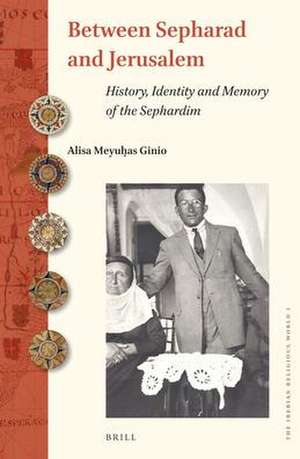Between Sepharad and Jerusalem: History, Identity and Memory of The Sephardim: The Iberian Religious World, cartea 1
Autor Alisa Meyuḥas Ginioen Limba Engleză Hardback – 15 oct 2014
Preț: 872.03 lei
Preț vechi: 1063.44 lei
-18% Nou
Puncte Express: 1308
Preț estimativ în valută:
166.87€ • 175.02$ • 138.91£
166.87€ • 175.02$ • 138.91£
Carte indisponibilă temporar
Doresc să fiu notificat când acest titlu va fi disponibil:
Se trimite...
Preluare comenzi: 021 569.72.76
Specificații
ISBN-13: 9789004279483
ISBN-10: 9004279482
Pagini: 374
Dimensiuni: 155 x 235 x 25 mm
Greutate: 0.73 kg
Ediția:New.
Editura: Brill
Colecția Brill
Seria The Iberian Religious World
ISBN-10: 9004279482
Pagini: 374
Dimensiuni: 155 x 235 x 25 mm
Greutate: 0.73 kg
Ediția:New.
Editura: Brill
Colecția Brill
Seria The Iberian Religious World
Cuprins
Contents
List of Figures
Introduction
Jerusalem Once upon a Time
Who is a Sephardi?
The Language of the Sephardim
Conclusion
1. From Expulsion to Revival
The Expulsion from Spain
To Where did the Exiled Turn to Go?
Portugal
Navarre
North Africa: Morocco, Algeria, Tunisia and Libya
Italy
The Ottoman Empire
Leaders of the Sephardi Communities in the Ottoman Empire in the Sixteenth Century Jerusalem
Safed
Tiberias
Hebron
The Ottoman Empire Sixteenth to Twentieth Centuries
The Turkish Republic
Conclusion
2. The Meʿam Loʿez: The Masterpiece of Ladino Literature (Eighteenth–Nineteenth Centuries)
The Anthology Meʿam Loʿez
Everydaylife of the Sephardim in their Mediterranean Dispersal According to the Meʿam Loʿez
3. Immigrants in the Land of Their Birth: The Sephardi Community in Jerusalem. The Test Case of the Meyuḥas Family
Modernization Processes in the Ottoman Empire
The Alliance Israelite Universelle
A Jerusalemite Sephardi Family in the Change of Time: The
Test Case of The Meyuḥas Family
The History of the Meyuḥas family in the Balkans and in Istanbul (Kushta)
The Meyuḥas Family in Jerusalem: The Meguilat Yoḥasin of the Rishon Le-Zion Rabbi Refael Meyuḥas and the Purim de los Meyuḥasim
The Descendants of Rabbi Refael Meyuḥas
Shadarim of the Meyuḥas Family
The Meyuḥas Family in Kefar Ha-Shiloʾaḥ
Conclusion
4. Beautiful Damsels and Men of Valor: Ladino Literature Giving Us a Peek into the Spiritual World of Sephardi Women in Jerusalem (Nineteenth and Twentieth Centuries)
Ladino Books Kept by Nona Flor
Nona Flor the Storyteller
Old Readers and New Readers
Conclusion
5.The Spanish Senator Dr. Ángel Pulido Fernández and the “Spaniards without a Homeland,” Speakers of Jewish Spanish 248
Dr. Angel Pulido Fernandez and the Sephardim
How Did the Sephardim React to Pulido’s Ideas?
Conclusion
6.The Lost Identity of the Sephardim in The Land of Israel and the State of Israel
The Weekly Hed Ha-Mizraḥ and its Readers
The Second World War in Greece: The Extermination of the Jews
The Sephardim of the Land of Israel Facing the Holocaust
Epilogue: History in the Eyes of the Beholder
Bibliography
Hebrew Bibliography
Other Languages Bibliography
Index
List of Figures
Introduction
Jerusalem Once upon a Time
Who is a Sephardi?
The Language of the Sephardim
Conclusion
1. From Expulsion to Revival
The Expulsion from Spain
To Where did the Exiled Turn to Go?
Portugal
Navarre
North Africa: Morocco, Algeria, Tunisia and Libya
Italy
The Ottoman Empire
Leaders of the Sephardi Communities in the Ottoman Empire in the Sixteenth Century Jerusalem
Safed
Tiberias
Hebron
The Ottoman Empire Sixteenth to Twentieth Centuries
The Turkish Republic
Conclusion
2. The Meʿam Loʿez: The Masterpiece of Ladino Literature (Eighteenth–Nineteenth Centuries)
The Anthology Meʿam Loʿez
Everydaylife of the Sephardim in their Mediterranean Dispersal According to the Meʿam Loʿez
3. Immigrants in the Land of Their Birth: The Sephardi Community in Jerusalem. The Test Case of the Meyuḥas Family
Modernization Processes in the Ottoman Empire
The Alliance Israelite Universelle
A Jerusalemite Sephardi Family in the Change of Time: The
Test Case of The Meyuḥas Family
The History of the Meyuḥas family in the Balkans and in Istanbul (Kushta)
The Meyuḥas Family in Jerusalem: The Meguilat Yoḥasin of the Rishon Le-Zion Rabbi Refael Meyuḥas and the Purim de los Meyuḥasim
The Descendants of Rabbi Refael Meyuḥas
Shadarim of the Meyuḥas Family
The Meyuḥas Family in Kefar Ha-Shiloʾaḥ
Conclusion
4. Beautiful Damsels and Men of Valor: Ladino Literature Giving Us a Peek into the Spiritual World of Sephardi Women in Jerusalem (Nineteenth and Twentieth Centuries)
Ladino Books Kept by Nona Flor
Nona Flor the Storyteller
Old Readers and New Readers
Conclusion
5.The Spanish Senator Dr. Ángel Pulido Fernández and the “Spaniards without a Homeland,” Speakers of Jewish Spanish 248
Dr. Angel Pulido Fernandez and the Sephardim
How Did the Sephardim React to Pulido’s Ideas?
Conclusion
6.The Lost Identity of the Sephardim in The Land of Israel and the State of Israel
The Weekly Hed Ha-Mizraḥ and its Readers
The Second World War in Greece: The Extermination of the Jews
The Sephardim of the Land of Israel Facing the Holocaust
Epilogue: History in the Eyes of the Beholder
Bibliography
Hebrew Bibliography
Other Languages Bibliography
Index
Notă biografică
Alisa Ginio, Ph.D. (1989) in History, Tel Aviv University, is a Professor Emeritus of History at the Department of History, Tel Aviv University. Her publications deal with Christian polemics contra judaeos in the Iberian Peninsula; the Iberian conversos and the Jewish-Spanish speaking Sephardim.






